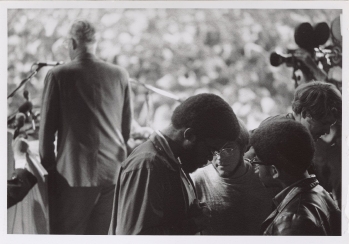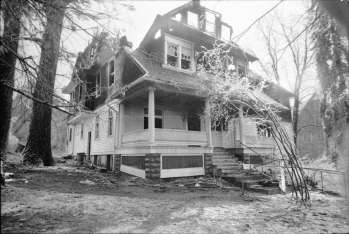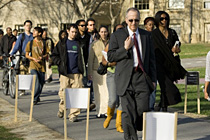CAMPUS LIFE
40 years ago, a campus takeover that symbolized an era of change

The Pulitzer Prize-winning photo of Cornell students emerging from Willard Straight Hall after the takeover.
Early in the morning of Parents' Weekend, April 18, 1969, 11 fire alarms rang out across the Cornell campus. At 3 a.m., a burning cross was discovered outside Wari House, a cooperative for black women students. The following morning, members of the Afro-American Society (AAS) occupied Willard Straight Hall to protest Cornell's perceived racism, its judicial system and its slow progress in establishing a black studies program.
The events that were to prompt decades of social, cultural and political change on campus were in play.
At 9:40 a.m., in an attempt to take the building back, white Delta Upsilon fraternity brothers entered the Straight and fought with AAS students in the Ivy Room before being ejected. Fearing further attacks, the black students brought guns into the Straight to defend themselves.
On the evening of April 19, in freezing rain, rookie Cornell police officer George Taber patrolled the perimeter of the occupied Willard Straight Hall unarmed. Students for a Democratic Society members -- students far to the left of many of the black students inside -- formed a ring around the Straight to lend support.
Today, Taber recalls the period as "a whirlwind. One thing after another. I was a raw rookie. I had no idea what was going on."
Within hours, police deputies from Rochester, Syracuse and across New York state massed in downtown Ithaca. "Had they gotten the command to do so, they would have gone and taken the Straight back and arrested people, or who knows what would have happened. It could have made Kent State and Jackson State look like the teddy bear's picnic. It would have been just absolutely terrible," Taber reflects.
On Sunday afternoon, following negotiations with Cornell officials, the AAS students emerged from the Straight carrying rifles and wearing bandoleers. Their image, captured by Associated Press photographer Steve Starr, appeared in newspapers across the country and on the cover of Newsweek magazine under the headline "Universities Under the Gun."
Although physical disaster was averted, deep psychological scars were burned into the minds of many on campus. Four decades later, feelings in some quarters are still raw. The university as a bastion of reasoned argument, thoughtful debate and academic freedom seemed to be under siege. Relationships among faculty members were destroyed. Students were torn. An atmosphere of pervasive fear and anxiety gripped the campus and the nation. The AAS students were not punished, outraging some faculty members, students and alumni.
Within Cornell, the takeover has come to be seen as an event that gave birth to enormous social, governance and ideological change. In fact, institutional change was already under way.

Cornell President James A. Perkins addresses a large crowd in Barton Hall as students confer, April 23, 1969. See larger image
In 1963, his first year in office, Cornell President James Perkins had launched the Committee on Special Educational Projects (COSEP) to increase enrollment of African-American students at Cornell and provide them with support services -- the first program of its kind at a major American university.
Perkins, who had chaired the board of trustees of the United Negro College Fund, said Cornell wanted to "make a larger contribution to the education of qualified students who have been disadvantaged by their cultural, economic and educational environments." COSEP later expanded to include Latino and Hispanic American, Native American and Asian-American students.
Only days before the Straight takeover, on April 10, 1969, the Cornell administration had approved $240,000 to create an Afro-American Studies Center and a director, James Turner, had been chosen. "The students wanted an autonomous program; they wanted the center to have control of its own destiny," says Eric Acree, librarian at the Africana Studies and Research Center.
But change did come even more quickly after the takeover. "You now have recognition that other people need to be studied -- women, gays and lesbians, Latinos, Asian Americans -- all of that is an outgrowth of this movement," Acree says.
According to Robert L. Harris, professor of Africana studies, entire scholarly fields had been ignored. "The seriousness of Africana studies as an academic endeavor had been questioned, simply because the breadth and depth of existing scholarship was not widely known," he says. "In the decades since, the field has been the source of vast quantities of indisputably serious, relevant, compelling work."

The remains of the first Africana Center on Wait Avenue after it was burned by an arsonist on April 1, 1970. See larger image
As the academic canon broadened, so did student living options with the establishment of Ujamaa Residential College in 1971, followed by Akwe:kon in 1991 and the Latino Living Center in 1994. The current Africana Studies and Research Center building opened in 2005 (the first center was destroyed by arson in 1970). Students and staff now serve on the Cornell Board of Trustees. The university's need-blind admissions policy and Student Assembly can also be traced to the takeover. And, only this year, an Asian and Asian-American student center was approved.
Perkins resigned at the end of the semester after the takeover, and for years he was widely regarded as a decent but ineffectual president. But in 1995 Thomas W. Jones, a leader of the takeover, established the James A. Perkins Prize for Interracial Understanding and Harmony, to acknowledge the historic role that Perkins played in changing Cornell.
"President Perkins made the historic decision to increase very significantly the enrollment of African-American and other minority students at Cornell," said Jones at the time. "He did so in the conviction that Cornell could serve the nation by nurturing the underutilized reservoir of human talent among minorities, and in the faith that the great American universities should and could lead the way in helping America to surmount the racial agony which was playing out in the civil rights struggles of the 1950s and 1960s. He made a courageous and wise decision and deserves recognition for it."
The radical ideals Ezra Cornell advanced in 1865 to found his university survived -- though the tumultuous events of the late 1960s forced them to adapt. But in the end, after a long period of radical change, they have ultimately thrived.
